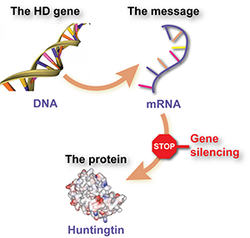Gene Silencing
(biotechnology, medical concept) | |
|---|---|
 | |
| A method of "switching off" of a gene by a mechanism other than genetic engineering. The question remains of who get to decide which genes are "silenced", and how to control this, for example in mRNA vaccines. |
Gene silencing is a general term describing epigenetic processes of gene regulation. It is used to describe the "switching off" of a gene by a mechanism other than genetic engineering. That is, a gene which would be expressed ("turned on") under normal circumstances is switched off by machinery in the cell. When a gene is silenced it means that its RNA is unable to make a protein.
Gene silencing is believed to have a large potential in the treatment of conditions such as cardiovascular diseases, viral infections, and cancer. RNA interference (RNAi) is one technique to silence genes, but the clinical application of RNAi remains a challenge because of the difficulty in achieving successful delivery to the right place. Finding an effective nanocarrier delivery systems also remain a challenge to enable the full therapeutic potential of RNAi.[1]
The obvious deep politics aspect of this is the question of who get to decide which genes are "silenced". The technology has therapeutic potential, but also all sorts of other possible applications, especially if lacking proper oversight, like the development and rollout of COVID-19 vaccines.
Contents
Explanation
To understand gene silencing, you need to understand how genes work in the body. Proteins are generated at the molecular level and they act as tiny machines inside of cells. They make chemical reactions take place, communicate messages and give cells their structure, among other things.[1]
Each different protein is made using instructions called a gene. Genes are made from DNA and they live in the nucleus of each cell. Genes do not make proteins directly. Instead, they use a DNA sequence of the gene as a template to make a message molecule.[1]
This messenger molecule is called messenger RNA or mRNA. It is the mRNA that tells the cell what building blocks to use to create the protein. When a gene is not functioning properly, it instructs the body to produce a version of the protein in question which can ultimately damage the cell.[1]
There is a two-step process for a gene to produce a corresponding protein.
First a copy of the information is encoded in a gene made in the form of the mRNA. This process is known as transcription.
Transcription happens in the nucleus of the cell where all of the cells genetic material is contained. The mRNA then travels outside of the nucleus along with the genetic information it carries which is used to produce a specific protein. This process in known as translation.[1]
The idea behind gene silencing is to intervene in the gene expression prior to translation taking place. By designing a molecule that can specifically identify and breakdown the mRNA instructions for making a certain protein, scientists have been able to decrease, or silence, levels of that protein.[1]
Essentially, the information needed to produce the protein in a cell is being blocked or censored in the mRNA message. When this information cannot be carried into a cell, it silences the gene that is providing these instructions.
RNAi-based therapies
RNA interference (RNAi) is a highly specific approach to gene silencing, believed to have a large potential in the treatment of conditions such as cardiovascular diseases, viral infections, and cancer.[1]
The RNA interference (RNAi) pathway regulates mRNA stability and translation in nearly all human cells. Small double-stranded RNA molecules can trigger RNAi silencing of specific genes, but their therapeutic use has faced a lot of issues involving safety and potency.
RNAi therapies are widely used in preclinical models, but the clinical application of RNAi remains a challenge because of the difficulty in achieving successful delivery to the right place. Effective delivery systems are essential to enable the full therapeutic potential of RNAi.
An ideal nanocarrier needs to address chemically unstable features, extracellular and intracellular barriers, and innate immune stimulation, as well as offering "smart" targeted delivery. Over the past decade, great efforts have been undertaken to develop RNAi delivery systems that overcome these obstacles.
Therapeutics challenges
There are several challenges associated with gene silencing therapies, including delivery and specificity for targeted cells. For instance, for treatment of neurodegenerative disorders, molecules for a prospective gene silencing therapy must be delivered to the brain. The blood-brain barrier makes it difficult to deliver molecules into the brain through the bloodstream by preventing the passage of the majority of molecules that are injected or absorbed into the blood.[2] Thus, researchers have found that they must directly inject the molecules or implant pumps that push them into the brain.[2]
Once inside the brain, however, the molecules must move inside of the targeted cells. In order to efficiently deliver siRNA molecules into the cells, viral vectors can be used.[2][3] Nevertheless, this method of delivery can also be problematic as it can elicit an immune response against the molecules. In addition to delivery, specificity has also been found to be an issue in gene silencing. Both antisense oligonucleotides and siRNA molecules can potentially bind to the wrong mRNA molecule.[2] Thus, researchers are searching for more efficient methods to deliver and develop specific gene silencing therapeutics that are still safe and effective.
Further Reading